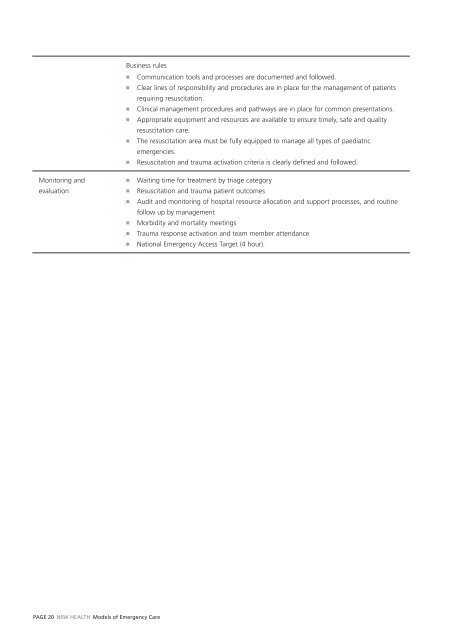Emergency Department Models of Care 2012 - NSW Health
Emergency Department Models of Care 2012 - NSW Health Emergency Department Models of Care 2012 - NSW Health
Business rules■■■■■■Communication tools and processes are documented and followed.Clear lines of responsibility and procedures are in place for the management of patientsrequiring resuscitation.Clinical management procedures and pathways are in place for common presentations.Appropriate equipment and resources are available to ensure timely, safe and qualityresuscitation care.The resuscitation area must be fully equipped to manage all types of paediatricemergencies.Resuscitation and trauma activation criteria is clearly defined and followed.Monitoring andevaluation■■■■■■Waiting time for treatment by triage categoryResuscitation and trauma patient outcomesAudit and monitoring of hospital resource allocation and support processes, and routinefollow up by managementMorbidity and mortality meetingsTrauma response activation and team member attendanceNational Emergency Access Target (4 hour).PAGE 20 NSW HEALTH Models of Emergency Care
3.4 Acute Care2 hoursED Senior Assessment Streaming Early Treatment ZoneTriageRegistrationAcuteWhat is the model?Why use the model?The Acute Care Model of Care is a set of principles and processes that aim to promoteefficiency in initiating, assessing, performing and transferring the care of patients who areacute, potentially unstable and complex. These are patients that require:■■■■■Cardiac monitoringFrequent observationSpecialised interventionsA higher level of careA more comprehensive management plan.An Acute Care MOC is essential in all EDs to:■■■■■Focus on the optimal treatment of acutely ill patientsProvide access to acute care in a timely mannerPromote initial assessment by senior physician decision maker, allowing focussedinvestigations and treatment, and reducing any duplication of work between Junior andSenior Medical Officers, and other clinical providers (for example, CIN)Improve turnaround time for diagnostics and specialist reviewStandardise processes for consistent results.Key Principles ■ An initial senior assessment by a senior ED Physician to establish the patient managementplan and likely disposition■■■■■■■Adoption of a team approach to patient managementTimely access to specialist consultants and diagnostic turnaround timesCoordination of care using clinical pathways (for example, chest pain pathway, sepsispathway)Promoting a culture to regularly review patients to progress them to the next point ofcareA standardised process for handover of patients from ED medical staff to inpatient orcommunity medical staffCompliance with policies supporting the timely movement of admitted patients from theED to an inpatient unitA standardised clinical environment for each acute bed, that is, each bed area is setupand stocked with standardised equipment and organised using the principles of leanthinking.Models of Emergency Care NSW HEALTH PAGE 21
- Page 2 and 3: NSW MINISTRY OF HEALTH73 Miller Str
- Page 4: Executive SummarySince the publicat
- Page 7 and 8: 1.2 A review of Emergency Modelsof
- Page 9 and 10: ■■■patients who need only a s
- Page 11 and 12: SECTION 3Emergency Department Model
- Page 13 and 14: In determining your skill mix requi
- Page 15 and 16: Benefits of the model ■ Improved
- Page 17 and 18: 3.2 Clinical Initiatives NurseResus
- Page 19 and 20: ■■Demonstrated ability to inter
- Page 21: Predictive planning■■■■■
- Page 25 and 26: What you need to runthe modelStaff
- Page 27 and 28: Key principles ■ This is not a st
- Page 29 and 30: Monitoring andevaluation■Waiting
- Page 31 and 32: Challenges ■ Establishing guideli
- Page 33 and 34: 3.7 Fast trackED Senior Assessment
- Page 35 and 36: What you need to runthe modelStaff
- Page 37 and 38: 3.8 Sub-acute2 hoursED Senior Asses
- Page 39 and 40: 3.9 2 : 1 : 12:1:1This model requir
- Page 41 and 42: Monitoring andevaluation■■■
- Page 43 and 44: Why use the model?Key principlesBen
- Page 45 and 46: What you need to runthe modelStaff
- Page 47 and 48: SECTION 4Streamlining access to acu
- Page 49 and 50: Challenges ■ Identification of
- Page 51 and 52: ■■■Patient Flow pathways and
- Page 53 and 54: Case for implementationWhat you nee
- Page 55 and 56: Operating Principles■■■■■
- Page 57 and 58: Case for implementationWhat you nee
- Page 59 and 60: Mental Health LiaisonNursesApproxim
- Page 61 and 62: 5.1 Urgent Care CentreThe Urgent Ca
- Page 63 and 64: 5.3 Connecting CareWhat is the mode
- Page 65 and 66: SECTION 7Self-Assessment ToolsInclu
- Page 67 and 68: NHS Gloucestershire 2006, UK Urgent
Business rules■■■■■■Communication tools and processes are documented and followed.Clear lines <strong>of</strong> responsibility and procedures are in place for the management <strong>of</strong> patientsrequiring resuscitation.Clinical management procedures and pathways are in place for common presentations.Appropriate equipment and resources are available to ensure timely, safe and qualityresuscitation care.The resuscitation area must be fully equipped to manage all types <strong>of</strong> paediatricemergencies.Resuscitation and trauma activation criteria is clearly defined and followed.Monitoring andevaluation■■■■■■Waiting time for treatment by triage categoryResuscitation and trauma patient outcomesAudit and monitoring <strong>of</strong> hospital resource allocation and support processes, and routinefollow up by managementMorbidity and mortality meetingsTrauma response activation and team member attendanceNational <strong>Emergency</strong> Access Target (4 hour).PAGE 20 <strong>NSW</strong> HEALTH <strong>Models</strong> <strong>of</strong> <strong>Emergency</strong> <strong>Care</strong>



